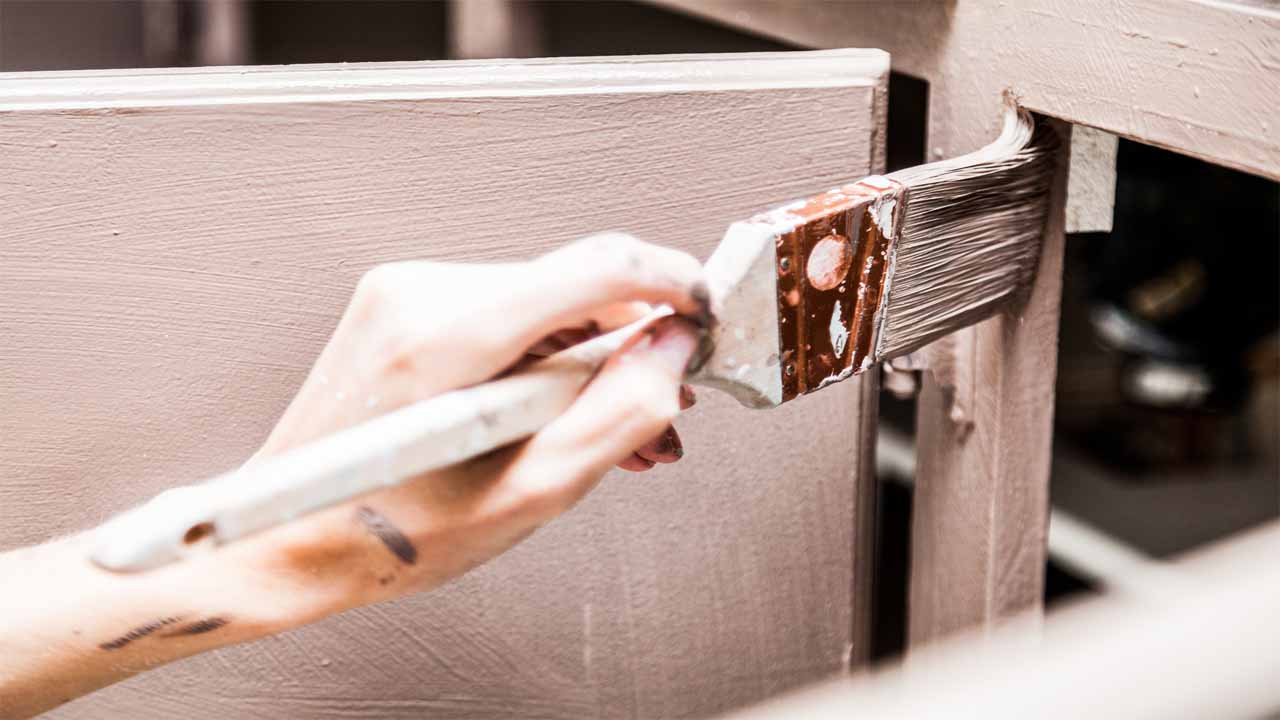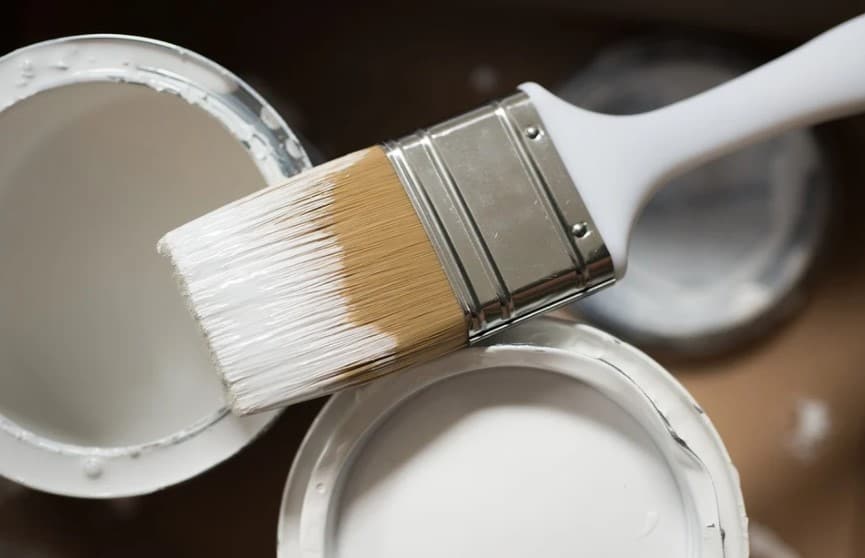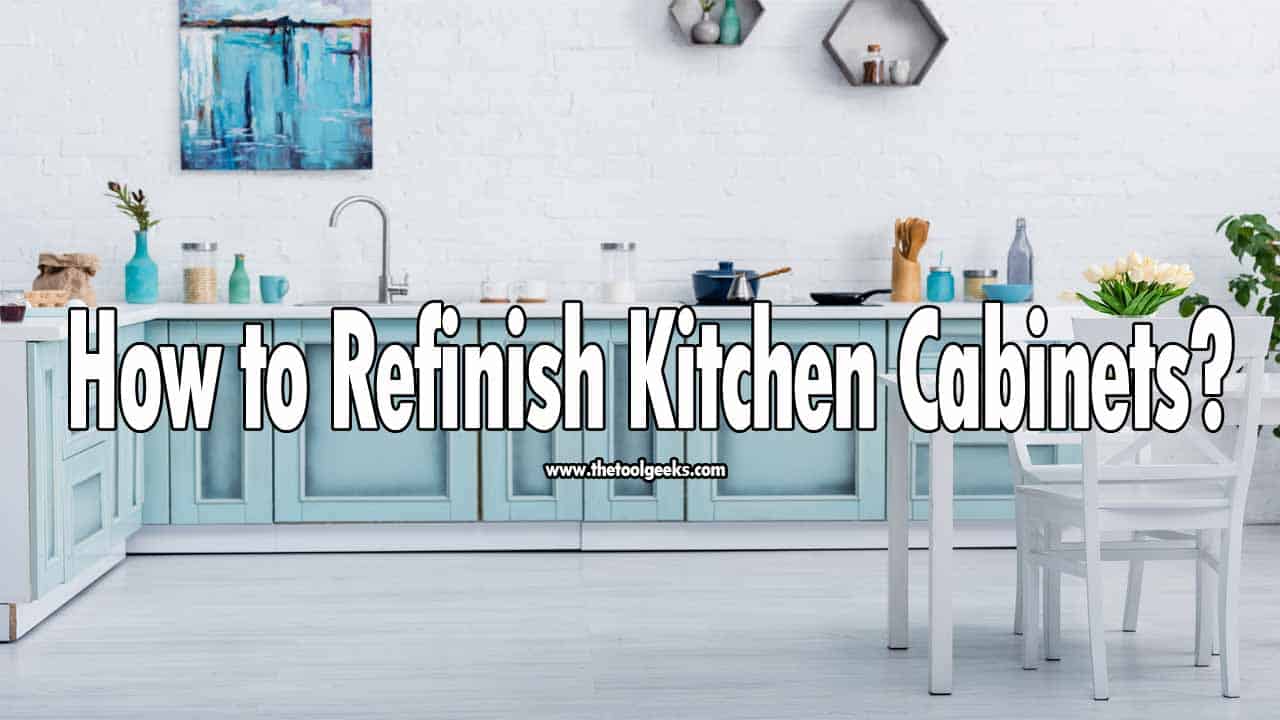How to Prep and Paint Kitchen Cabinets? 10 Steps You Have to Follow
TheToolGeeks.com is a participant in the Amazon Services LLC Associates Program and other affiliate advertising programs. We may earn from qualifying purchases. (Learn More).
If you are someone who fancies home décor and style, then having a defaced kitchen cabinet would surely be at the bottom of your list. A defaced kitchen cabinet would have your kitchen looking scruffy no matter how much redecorating you do. When the cabinet no longer maintains its preexisting finesse, then there is a need for change.
Luckily, you don’t need to break the bank trying to get money to replace the kitchen cabinets which for the record can be a bit costly. So what do you do to reinstate the fine nature of the kitchen cabinets without having to spend so much on materials and workmanship?
The answer is you refinish the kitchen cabinets. Refinishing your kitchen cabinet simply means applying a new coat of paint or finish on the kitchen cabinet. But that’s just the simple answer.
There is more to know about how to refinish kitchen cabinets. This post will introduce you to the best way to refinish your kitchen cabinets as well as the tips you need to know to get it done quickly and easily. So let’s refinish that kitchen cabinet.
Jump To Page Contents:
What Does It Mean to Refinish Your Kitchen Cabinet?
Refinishing kitchen cabinets means you strip off the previous paint or finish on the kitchen cabinet either via hand sanding or using paint strippers. Then you repaint the wood or apply a new finishing coat. It’s a great method to revitalize the look and feel of the cabinet without having to tear it down or replace it with entirely new cabinets. Think of refinishing as repainting your house.
Refinishing is usually done with cabinets or wood that is still in good condition. It is also advised for people who want a pocket-friendly alternative to give their kitchen cabinets a new look.

The major advantage of refinishing a kitchen cabinet is that the whole process is not costly. It is also a task you can do yourself. You don’t need a wide array of materials other than a new paint or finish, a paint stripper or sandpaper, and a few other tools.
However, before you attempt to refinish your kitchen cabinets, you should know that there are some cabinets that you can’t strip paint or finish off and there are some materials you can’t repaint. This is because of the material or type of wood that was used to make the said cabinets.
Cabinets made from Thermo foil, Oak, Hard Maple, or Laminate shouldn’t be painted and the natural finish of these materials shouldn’t be stripped off.
Attempting to strip off the color from some of these materials isn’t ideal and the new paint or finish wouldn’t stick on cabinets made from them. For instance, paints wouldn’t do well on cabinets made from Thermo foil.
While it is rare to see kitchen cabinets made from such materials, it’s still advised to check what type of wood or material your kitchen cabinet was made from to prevent extra damage.
Read More — Best Paint Sprayers For Kitchen Cabinets
Should You Use a Paintbrush or Paint Sprayer to Paint Your Kitchen Cabinet?
When it comes to applying paint on kitchen cabinets, you have two alternatives; the paintbrush or the paint sprayer.
Both tools will work very well for your kitchen cabinets but the one you decide to use will depend on the size of the cabinet, which of the two equipment you are familiar with, and your budget especially if you have to buy either.
A paint sprayer will cost way more than a paintbrush. Though both methods will suffice for a kitchen cabinet, I will recommend using a paint sprayer.
A paint sprayer will give you faster application of paint to the cabinets. Once you are done prepping the paint sprayer, you can aim the nozzle at the cabinet and achieve a good paint job will just one dash.
Also, with a paint sprayer, you are guaranteed a smooth and wide coverage of the cabinets. The sprayer will cover more sections quickly while applying a fine coat of paint on the surface too.
You don’t need to worry about brush marks, traction, or imperfections on the cabinets as you would if using a paintbrush. The paint sprayer will rid all of that easily.
This is not to say a pint sprayer doesn’t have its cons. A paint sprayer is more suited for large-scale tasks and kitchen cabinets do not exactly qualify as large scale so it’s possible you overspray with a paint sprayer.
A paint sprayer also takes a longer time to prepare. You need to prime the pump, select a tip, test it out, and so on before you can use it but after you have prepped the paint sprayer, it’s a very efficient tool to use.
Read More — Paint Rollers vs Paint Sprayers?
How to Prep and Refinish Kitchen Cabinets?
I know how difficult it may sound to refinish your kitchen cabinets but trust me it’s not that difficult. It’s very easy and a fun task to take on too. The steps below will help you achieve a finished kitchen cabinet that you will be proud of.
Put on Your Safety Gear
Put on your pair of work gloves, goggles, a face mask, and long clothes before you begin. Refinishing kitchen cabinets will have you handling wooden boards that can have splinters, working with paints that can have toxic fumes, and the lot. Protect yourself from any potential accidents.
Remove All Hardware
Take out all cutleries, plates, beverages, and other food items from the kitchen cabinets. Spraying paint on the cabinet with food in it will poison the food items. The paint can also damage the other items and even break the ceramics.
Tape the Walls, Cover the Floor, and Cover the Furniture
It’s usually better to remove all nearby furniture from the kitchen. Any furniture that can’t be moved should be covered with plastic sheeting, drop cloth, or tarp to prevent paint from dripping on them. Use duct tape to cover wall trims, edges, and door frames.
Provide Light and Ventilation
You need to ensure the kitchen is well ventilated so air can come in and there is enough light so you can see what you are doing. If the kitchen is well ventilated, you have nothing to worry about.
Read More — Best HVLP Spray Gun For Woodworking
Sand the Cabinets
The next thing to do is to sand the cabinets. Sanding the cabinets will improve the adhesiveness of the wood and also remove the previous finish or paint from the wood.
To sand, use coarse sandpaper like the 80 grit sandpaper to sand the cabinets and then use fine-grit sandpaper like the 180 or 220-grit sandpaper to finish the surface of the wood so it’s smooth and ready to absorb the paint.
You don’t need to use a primer on kitchen cabinets except you want to use a lighter color than you previously had. If you use a light paint color on a darker one, you will need to use more coats of paint to cover the darker color and even that might not be enough.
It’s still possible you will see shades of the previous color when the new one dries. You might also need to use a primer depending on the wooden material used to make the cabinets. So use a primer if necessary though I doubt you will need to.
Read More — Best LVLP Spray Guns
Prime the Paint Sprayer
If you are using a paint sprayer, then you need to prime it before using it. Priming the sprayer will ensure paint flows well without clogging.
Think of it as prepping the sprayer. Switch off and unplug the sprayer. Then put the suction tube inside the paint bucket and the return tube in a waste container.
Plug-in the sprayer and switch it on. Then turn the prime and spray valve to prime. The valve is usually a black knob or valve at the rear of the spray-gun.
As soon as you see the paint flowing, switch off the sprayer, and put the return tube inside the paint bucket to avoid wasting paint. Then switch on the sprayer and continue with the task.
Spray the Paint
Before you spray the paint, you need to select the right tip. Check the sprayer manual for recommendations on the tip to use or ask a professional painter.
Then install the tip at the nozzle of your spray gun. When that is done, you can go ahead to spray. As a precaution, test the sprayer on a disposable board to check the spray level. If you are satisfied, you can go ahead to spray the kitchen cabinet.
Pay attention to the corners, edges, and inner parts of the kitchen cabinets. You also need to spray the underneath of the kitchen cabinets.
Your kitchen cabinets may be detachable. If they can be removed, then that makes it all easier. You can take the cabinets outside to spray them under the natural light.
Clean Up and Leave the Paint to Dry
As soon as you are done painting, clean up the sprayer with solvent or paint thinner and store it properly. Then leave the paint to dry. After a while, you can remove the tapes from the walls and let the paint cure properly.
Read More — When Is It Too Cold to Paint?
Why Should You Refinish Your Kitchen Cabinet?
There are different reasons to refinish a kitchen cabinet.
- It’s cheaper than replacing the kitchen cabinet. Refinishing your kitchen cabinet is a cheaper alternative to replacing the cabinets. If your kitchen cabinet is still in good condition, then you can just apply a new finish rather than installing an entirely new kitchen cabinet.
- It makes your kitchen cabinet look as good as new. Refinishing a kitchen cabinet will give it that same look as when you installed it initially.
- It increases the durability of the kitchen cabinet. By refinishing your cabinet, you are indirectly extending the lifespan of the cabinet meaning it will last longer. The new coat of paint or finish will prevent dust, heat, and dirt from coming in contact with the wood.
- It makes your kitchen look neater. Nothing makes a room look neater and finer than a new or in this case, a good as new furniture.
- You get a wide array of options. When you decide to refinish your kitchen cabinet, you will have so many options to choose from. You can pick a different paint color or finish than the one that was there before. Anyone who walks into the kitchen might even think you had new cabinets installed.
What Type of Paint Do You Need for Your Kitchen Cabinets?

When learning how to refinish kitchen cabinets, an important factor to consider is which paint you need for the cabinet as there are different types of paint types you can use. But before picking a type of paint, you need to consider some factors such as:
- The price of the paint. The paint you pick has to fit into your budget. Don’t fret though as there are many pocket-friendly paints out there for you to pick from.
- The durability of the paint. Kitchens are often one of the busiest rooms in a house. There is usually a mixture of heat, steam, moisture, and vapor circulating. The hot air temperature might not work well in favor of many paint types as the paint can begin to peel off the walls after a while.
- The finish you are going for. The finish you are going for also determines the paint you will get. For instance, if you want your kitchen cabinets to sheen, then a glossy paint or semi-gloss paint will suffice.
- The type of material used to make the cabinet. The wooden material used to make the kitchen cabinet also determines the type of paint to be used on the material. For instance, Acrylic Latex-based paint will go well on wooden cabinets.
If you have considered the said factors, then it’s time to pick the paint. Here are some of the best paint types to pick from.
Read More — Different Paint Types?
Enamel Paint
Enamel paint is a popular choice for many homeowners when it comes to painting kitchen cabinets because it does a good job of concealing imperfections in the wood.
Enamel paints will hide any grain in the wood and give you a good finish too. The coat also increases the durability of the cabinet.
Acrylic-based Furniture Paint
This is a water-based paint that works very well on furniture. The paint bonds well to surfaces even without the prior use of a primer and it is also crack-resistant meaning that it has a high level of durability. This paint doesn’t peel or fall off easily.
Oil-based Paint
Oil-based paint or alkyd-based paint is another option though not a popular one. The paint gives a glossy finish and it also adheres well to surfaces without needing a primer.
This makes them suitable for virtually any cabinet. Also, you don’t need to worry about spraying or applying too many coats of oil-based paint.
A layer is usually enough. Here comes the downside, oil-based paints usually have a strong and sometimes disturbing smell which might not be good for kitchen use and it’s also quite difficult to clean.
Read More — Best Paint Sprayers for Beginners
Water-based Alkyd Paint
Water-based alkyd paint is a combination of water-based paint and alkyd paint. Both paint types are top choices for kitchen cabinets and the water-based alkyd paint combines both their properties. It’s like combining two flavors or Ice-cream.
The water-based alkyd paint is a top choice for painting kitchen cabinets. The paint is durable, easy to clean and maintain, cures (dries) well, and doesn’t give any nasty odor.
Ask professional painters for recommendations for kitchen cabinets and nine out of ten times, they will recommend alkyd-based paint.
Cabinet Paints
You might have come across paint buckets advertised as “cabinet paints.” These paint types are usually designed to cope with kitchen life.
They deal well with moisture and heat, they do not smell, and they are good with friction such as continuous touching, opening, and closing of the cabinet.
While these paints are sure to be a top choice, you need to be mindful of the one you buy as many of the paints said to be cabinet paints are just tagged so as a marketing strategy.
Tips to Get the Best Finish for Your Kitchen Cabinets
While refinishing a kitchen cabinet is a pretty easy and convenient task, you still need to exercise caution and take the right steps or you will end up with an eyesore for a kitchen cabinet.
- Use the right paint. You can’t just go for any paint out there. you need to pick a paint with improved durability, that can work well with heat and moisture, and a color that will fit the kitchen beautifully. You also need paint that dries quickly so you don’t have to worry about fumes and odors.
- Check the type of material the cabinet was made from. When you know the material your cabinet was made from, you will find it easier to pick the best paint for the cabinet.
- Cover the walls and remove all objects inside the cabinet. Unless you want to paint stains on the walls and objects around the cabinet, it’s best to take precautionary measures to ensure neatness and precision while painting.
- Sand the cabinets. Regardless of the type of paint, you will be using, you should sand the kitchen cabinets before painting so the paint can stick well to the surface.
- Don’t paint cabinets above the stove. It’s unusual to see a cabinet installed above the cooking section of the kitchen but if you do have one, it’s best to leave it unpainted as the steam and heat that emits while you are cooking will go directly to the cabinet and that will eventually cause the paint to melt prematurely. There is also a slim chance the paint that comes off will drop into the food you are preparing.
- Spray the inner parts of the cabinet. Don’t overlook the inner parts of the kitchen cabinets while painting.
- Clean the equipment immediately after use or you risk paint getting clogged in the paint sprayer.
So there you have it this is how to refinish kitchen cabinets. Refinishing kitchen cabinets is a task you can do yourself. Just follow the steps and tips above and you will end up with a nicely finished kitchen cabinet. Have a nice refinishing experience.
Read More — How to Spray a Car (Using LVLP Spray Gun)?
Amazon and the Amazon logo are trademarks of Amazon.com, Inc, or its affiliates.

